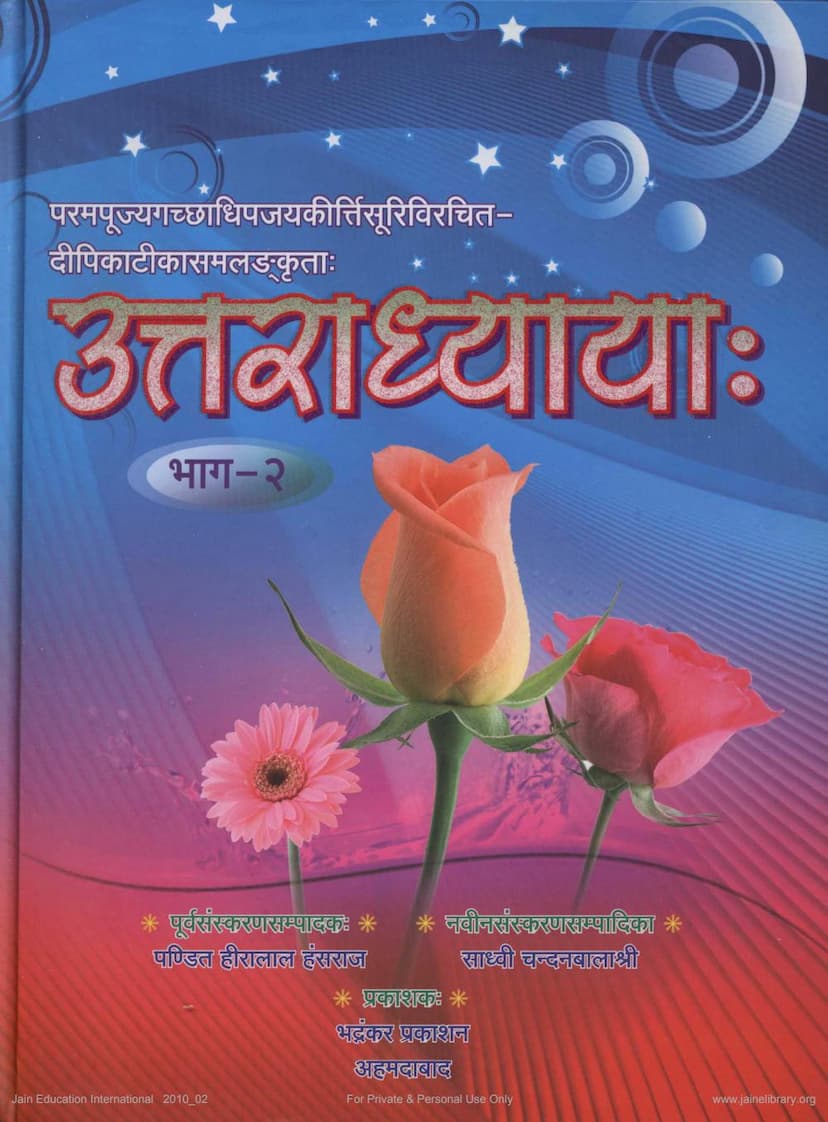Agam 43 Mool 04 Uttaradhyayan Sutra Part 02
Added to library: September 1, 2025

Summary
Here's a comprehensive summary of the provided Jain text, "Agam 43 Mool 04 Uttaradhyayan Sutra Part 02," authored by Jaykirtisuri and published by Bhadrankar Prakashan, based on the provided pages:
Book Title: Uttaradhyayan Sutra Part 02, adorned with the Deepika commentary by Param Pujya Gachhadhipati Jaykirtisuri.
Publisher: Bhadrankar Prakashan, Ahmedabad.
Year of Publication (New Edition): Vikram Samvat 2066 (2009 CE).
Overview:
This volume is the second part of the Uttaradhyayan Sutra, a foundational text in Jainism, which provides profound teachings on spiritual conduct and liberation. This specific edition is enriched with the "Deepika" commentary by Acharya Jaykirtisuri, a renowned Jain scholar. The publication aims to make this crucial text accessible for spiritual seekers, particularly for the study and contemplation of monks and nuns.
Key Aspects Highlighted in the Provided Pages:
-
Commentary and Authorship: The book features the "Deepika" commentary by Acharya Jaykirtisuri, a disciple of Acharya Merutungasuri. This commentary is known for its clarity, depth of meaning, and philosophical insights. The new edition's inspiration came from Panneas Shri Vajrasen Vijay Maharaj and Ganivarya Shri Naybhadra Vijay Maharaj, with the editing undertaken by Sadhvi Chundanbalashri.
-
Content of Part 2: This volume (Part 2) covers chapters 20 to 36 of the Uttaradhyayan Sutra. The summary of each chapter is provided, offering a glimpse into the diverse spiritual and ethical topics discussed.
-
Chapter Summaries (Selected Examples):
- Chapter 20 (Mahanirgranthiya Adhyayan): Discusses the path of the 'Nirgranthas' (unattached ascetics) and highlights how King Shrenik attained right faith through the example of Muni Anath. It emphasizes shedding attachments and following the path of true renunciation.
- Chapter 21 (Samudrapaliya Adhyayan): Narrates the story of Samudrapal, illustrating the importance of detachment from worldly pleasures and the attainment of spiritual realization through asceticism. It stresses the virtue of equanimity in the face of temptations.
- Chapter 22 ( Rathnemiya Adhyayan): Focuses on the story of Rathnemin, emphasizing the importance of steadfastness in spiritual practice. It highlights the struggle against passions and the ultimate triumph of virtue.
- Chapter 23 (Keshigautamiya Adhyayan): Presents a philosophical dialogue between Keshikumara and Gautama Swami, discussing various aspects of Jain doctrine, ethics, and the nature of true knowledge. It emphasizes the importance of discerning the true path from false ones.
- Chapter 24 (Pravachanmatri Adhyayan): Explains the significance of the eight cardinal rules (five Samitis and three Guptis) that guide the conduct of monks and nuns, highlighting their role in spiritual discipline.
- Chapter 25 (Yagniya Adhyayan): Illustrates the virtues of celibacy and Brahmacharya through the story of Jayghosh and Vijayghosh, emphasizing the transformative power of renunciation.
- Chapter 26 (Samachari Adhyayan): Details the ten-fold code of conduct for ascetics (Samachari), including aspects of daily routine, purity, and the rules governing their interactions and practices.
- Chapter 27 (Khankiya Adhyayan): Uses the example of the Garga Acharya and the stubborn ox to illustrate the characteristics of an unruly disciple and the importance of detaching from them for spiritual progress.
- Chapter 28 (Mokshamargagati Adhyayan): Outlines the path to liberation, emphasizing the four essential causes: knowledge, faith, conduct, and penance, along with their various classifications.
- Chapter 29 (Samyaktvaparakrama Adhyayan): Focuses on the practice of Samyakva (Right Faith) and its importance in spiritual development, highlighting virtues like detachment, equanimity, and devotion.
- Chapter 30 (Tapomargagati Adhyayan): Explains the significance and methods of penance (Tapa) in shedding karmic impurities and attaining liberation, detailing both external and internal austerities.
- Chapter 31 (Charanvidhi Adhyayan): Provides guidelines on righteous conduct (Charanvidhi) for ascetics, encompassing ethical principles, vows, and the renunciation of worldly desires and actions.
- Chapter 32 (Pramadasthan Adhyayan): Discusses the places of negligence (Pramad) and the means to overcome them, emphasizing the importance of vigilance, self-control, and devotion to the Guru.
- Chapter 33 (Karmaprakriti Adhyayan): Delves into the nature of Karma, describing the eight types of karmas, their specific karmic matter, duration, and their effects on the soul.
- Chapter 34 (Leshya Adhyayan): Explains the concept of Leshyas (subtle states of consciousness) and their impact on one's spiritual journey, detailing the characteristics of the six Leshyas (black, blue, grey, yellow, red, white) and their connection to karma.
- Chapter 35 (Angar Margagati Adhyayan): Focuses on the path of the true ascetic (Angar), outlining the virtues and conduct required for spiritual progress, including celibacy, self-discipline, and detachment.
- Chapter 36 (Jivajiva Vibhakti Adhyayan): Explains the fundamental Jain categories of Jiva (soul) and Ajiva (non-soul), detailing their characteristics, classifications, and the means to discriminate between them for spiritual liberation.
-
Significance of Uttaradhyayan Sutra: The text is described as the first among the Agam Granthas, serving as a guide for the path of Sadhana (spiritual practice). It is considered essential for monks and nuns for adherence to the code of conduct, filled with the teachings of the omniscient beings and examples of virtuous individuals.
-
Editorial and Publishing Efforts: The publication expresses gratitude to the inspirers, editors, and printers for their dedicated efforts in bringing out this new edition of the "Deepika" commentary, recognizing the spiritual value and the need to preserve this ancient knowledge. The use of "Shrut-Bhakti" (devotion to scripture) by various individuals and organizations is acknowledged, particularly the financial support from the Dissa Jain Shwetambar Murtipujak Sangh.
Overall Purpose:
The publication aims to facilitate the study and understanding of the Uttaradhyayan Sutra, particularly the profound commentary by Jaykirtisuri, enabling readers to internalize its teachings, cultivate virtues, and ultimately attain spiritual liberation. The summaries of the chapters suggest a comprehensive exploration of Jain philosophy, ethics, karma, spiritual practices, and the ultimate goal of Moksha (liberation).